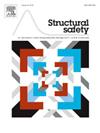Probabilistic prediction and early warning for bridge bearing displacement using sparse variational Gaussian process regression
IF 6.3
1区 工程技术
Q1 ENGINEERING, CIVIL
引用次数: 0
Abstract
Investigating the relationship between temperature variations and bridge bearing displacement is crucial for ensuring structural integrity and safety. However, the current temperature-displacement regression (TDR) model fails to account for inherent uncertainties in monitoring data and model errors. This paper proposes a probabilistic prediction and early warning framework for displacement of bridge bearing using the sparse variational Gaussian process regression (SVGPR) model. The time-varying relationships between temperature and bearing displacement at different time scales are analyzed. The SVGP-TDR model is constructed based on the fully independent training condition (FITC), and the induced points and hyperparameters are optimized simultaneously by combining variational learning and gradient descent method. An early warning method for bearing performance is proposed based on the model estimation error and Shewhart control chart theory, along with the implementation procedure provided. The effectiveness of the proposed method is verified using long-term monitoring data from an existing suspension bridge. The results show that the SVGP-TDR model can predict probability distribution of bearing displacement caused by temperature. Moreover, it can not only consider the uncertainty in the monitoring data, but also quantify the model error and prediction uncertainty. The proposed early warning method performs satisfactorily in assessing the service performance of bridge bearing.
基于稀疏变分高斯过程回归的桥梁支座位移概率预测与预警
研究温度变化与桥梁支座位移之间的关系对于保证结构的完整性和安全性至关重要。然而,目前的温度-位移回归(TDR)模型未能考虑监测数据的固有不确定性和模型误差。本文提出了一种基于稀疏变分高斯过程回归(SVGPR)模型的桥梁支座位移概率预测预警框架。分析了不同时间尺度下温度与轴承位移的时变关系。基于完全独立训练条件(FITC)构建SVGP-TDR模型,并结合变分学习和梯度下降法对诱导点和超参数进行同步优化。提出了一种基于模型估计误差和Shewhart控制图理论的轴承性能预警方法,并给出了实现步骤。利用某既有悬索桥的长期监测数据验证了该方法的有效性。结果表明,SVGP-TDR模型能较好地预测温度引起轴承位移的概率分布。不仅可以考虑监测数据的不确定性,还可以量化模型误差和预测不确定性。所提出的预警方法在评估桥梁支座的使用性能方面取得了满意的效果。
本文章由计算机程序翻译,如有差异,请以英文原文为准。
求助全文
约1分钟内获得全文
求助全文
来源期刊

Structural Safety
工程技术-工程:土木
CiteScore
11.30
自引率
8.60%
发文量
67
审稿时长
53 days
期刊介绍:
Structural Safety is an international journal devoted to integrated risk assessment for a wide range of constructed facilities such as buildings, bridges, earth structures, offshore facilities, dams, lifelines and nuclear structural systems. Its purpose is to foster communication about risk and reliability among technical disciplines involved in design and construction, and to enhance the use of risk management in the constructed environment
 求助内容:
求助内容: 应助结果提醒方式:
应助结果提醒方式:


